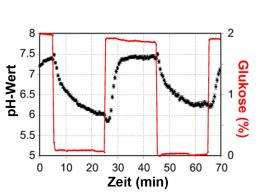Cells in the land of milk and honey

Researchers at the Institute of Biochemistry at ETH Zurich have discovered that cells measure their energy reserves with the aid of a sensor, which determines whether they are growing and dividing. This could be a general mechanism for how cells respond to excess nutrition.
Yeast cells use glucose, a type of sugar, to obtain energy and as a signalling substance. When they absorb glucose, this influences their pH value, which indicates whether something is acidic or alkaline. The higher the pH value, the more alkaline the cell interior. A group of researchers under Matthias Peter, Professor of Biochemistry at ETH Zurich, has now discovered that a high pH value gives cells the decisive stimulus to grow. When they fed yeast cells with glucose, the pH value in the cell interior rose. This is registered by a sensor protein, which triggers cell division.
Feast or famine
In their experiments, the researchers alternately gave yeast cells a large amount of glucose and then withheld it from them. After the sugar had been supplied, their pH value rose within a few minutes. If they were starved, their pH value dropped just as quickly.
However, Glucose fluctuations affect more than just the pH value. A sensor protein in the interior of the yeast cell also reacts to them. Only when a great deal of glucose is present does it become active. If there is little glucose, it ceases to function. The researchers therefore suspected that there was a connection between the sensor protein and the pH value.
Proof of this was provided by an experiment in which they gave the yeast cells sugar, but simultaneously kept their pH value artificially low. Although the cells had an excess of nutrition, they made no attempts to grow. The sensor protein had misled them: it had interpreted the low pH value as a lack of nutrition and had remained inactive.
Surprising sensor function
Although it has long been known that the sensor protein, V-ATPase, reacts to glucose content, its function as a pH sensor comes as a surprise. Up to now, it was only known to play a role in the digestion processes of the yeast cell. Just how it carries out its additional function is something over which the researchers are still puzzling. Reinhard Dechant, a postdoctoral student at the Institute of Biochemistry, conjectures that it could be something to do with digestion. Through the activity of the V-ATPase, it may be that an as yet unidentified factor is released from the vacuole, the “digestive organ” of the yeast cell. This factor could then transmit the growth signal.
Efficient utilisation
According to Dechant, the pH value could be a universal growth signal for cells. For it is not just yeast cells, but also cells that he examined from the pancreas, which grow when the pH value is raised. Conversely, the pH value of dividing cells is higher than that of dormant cells. This has been found, for example, in the case of tumour cells, which divide much more quickly than healthy cells.
Just how pH value and growth are related is not yet entirely clear. “We don’t know what is cause and what is effect,” concedes Dechant. For the cells, the mechanism would have a great advantage: instead of having to track down each nutrient individually, they could measure the utilisation of different nutrients via the pH value.
More information: Reinhard Dechant, Matteo Binda, Sung Sik Lee, Serge Pelet, Joris Winderickx, Matthias Peter. Cytosolic pH is a second messenger for glucose and regulates the PKA pathway through V-ATPase. The EMBO Journal (2010), 1-12. Published online: 25 June 2010. doi: 10.1038/emboj.2010.138















